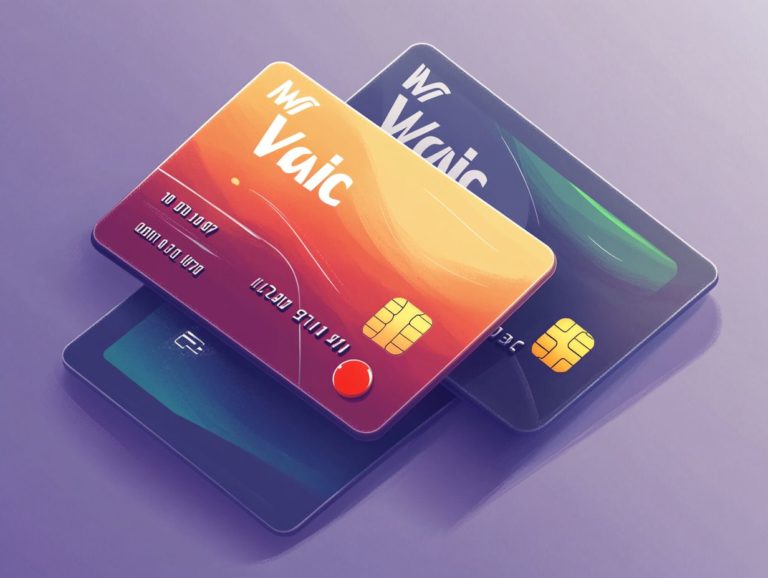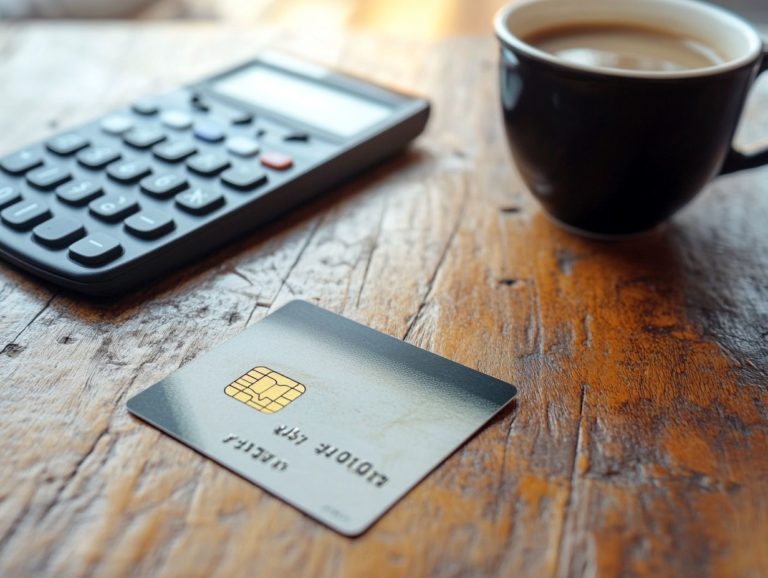What is Credit Card Overdraft Protection?
Overdraft protection serves as a crucial financial safety net, shielding you from the stress of unforeseen expenses and banking errors.
This guide delves into the fundamentals of overdraft protection, beginning with a clear definition and its intended purpose. It outlines how the system operates, including the associated processes and fees, and emphasizes the benefits it provides, such as the ability to sidestep overdraft fees and enhance convenience in your banking experience.
This guide discusses various types of overdraft protection, empowering you to make informed decisions tailored to your financial needs.
Contents
- Key Takeaways:
- Understanding Overdraft Protection
- How Overdraft Protection Works
- Benefits of Overdraft Protection
- Types of Overdraft Protection
- Frequently Asked Questions
- What is Credit Card Overdraft Protection?
- How does Credit Card Overdraft Protection work?
- Is Credit Card Overdraft Protection mandatory?
- What are the benefits of Credit Card Overdraft Protection?
- Are there any fees associated with Credit Card Overdraft Protection?
- Is Credit Card Overdraft Protection the same as a cash advance?
Key Takeaways:

- Overdraft protection is a service offered by banks to prevent overdraft fees and declined transactions on a credit card account.
- It works by linking a secondary account or providing a line of credit to cover any overdrafts on the primary account.
- The benefits of overdraft protection include avoiding fees, providing convenience, and offering peace of mind for unexpected expenses.
Understanding Overdraft Protection
Grasping the concept of overdraft protection is essential for anyone looking to master their financial management. This invaluable service ensures that when your checking or savings account balance runs low, you can still complete transactions without facing immediate penalties.
Tailored to enhance your financial stability, overdraft protection alleviates the anxiety tied to declined transactions and hefty fees, giving you the power to maintain a seamless cash flow and stay on track toward your financial aspirations.
Definition and Purpose
Overdraft protection serves as your financial safety net, allowing you to complete transactions even when your bank account balance dips below zero. This invaluable service is designed to ensure you can meet your financial commitments without facing penalties or missed payments.
Essentially, it saves you from those awkward moments of bounced checks or declined purchases.
There are primarily two types of overdraft protection available to you:
- Linking a savings account to your checking account.
- Obtaining a line of credit.
By granting you easy access to funds when you most need them, this service not only helps manage unexpected expenses but also aligns with your financial goals, offering peace of mind while keeping you in control of your budgeting practices.
How Overdraft Protection Works
Overdraft protection functions by connecting your primary bank account to an additional account be it a savings account or a line of credit. This creates a safeguard for those moments when your available funds fall short for a transaction.
This seamless link ensures that you can handle your banking with greater peace of mind, knowing you have a cushion to rely on.
Process and Fees

Utilizing overdraft protection comes with specific fees and regulations that you should be well-informed about to steer clear of unexpected costs.
Getting to know these fees can save you money! Understanding these fees is essential, as they can significantly impact your finances.
Overdraft fees, which are triggered when you spend more than your available balance, typically range from $30 to $40 per transaction, depending on your financial institution. If your bank covers an overdraft by transferring funds from a linked account, you might also encounter transfer fees.
On the flip side, Non-Sufficient Funds (NSF) fees (NSF, meaning you don t have enough money in your account) hit when a transaction is declined due to insufficient funds, adding yet another charge to your account. This fee structure varies from one bank to another and can even change based on the type of transaction think checks versus electronic payments.
To keep these costs at bay, consider setting up alerts for low balances, monitoring your spending diligently, and exploring low-cost overdraft services offered by some banks. Stay informed to avoid unnecessary charges!
Benefits of Overdraft Protection
The advantages of overdraft protection reach far beyond merely gaining access to additional funds; they foster financial stability and provide you with a sense of security as you navigate your financial landscape.
Embrace overdraft protection for a more secure financial future!
Avoiding Overdraft Fees
Avoiding overdraft fees is crucial for maintaining your financial health. You can take proactive steps to sidestep unnecessary charges.
One effective strategy is to set up account alerts that notify you when your balance dips below a certain threshold. This nudge helps you control your spending.
Understanding your bank s regulations particularly how they handle overdrafts and any associated fees gives you the power to make informed financial choices. Regularly monitoring your account balances through online banking or mobile apps is key in preventing accidental overdrafts.
Many financial institutions offer tools and resources designed to keep you on top of your finances, including budgeting advice and low-balance alerts. Utilizing these can significantly lower the chances of incurring fees.
Convenience and Peace of Mind
The service that helps you avoid overdrawing your account offers peace of mind, allowing you to confidently handle your essential payments, even during times of financial uncertainty.
This feature serves as your safety net, ensuring that crucial expenses like rent, utility bills, and unexpected medical emergencies are settled promptly. By utilizing this service, you can significantly reduce the stress that often accompanies financial shortfalls.
This allows you to focus on managing your daily life with greater ease. Overdraft protection seamlessly complements other payment options, such as automatic transfers and recurring debit payments, creating a smoother overall financial management experience.
Remember that responsible account management is crucial. Using this service wisely not only enhances your long-term financial stability but also helps you avoid costly fees.
Types of Overdraft Protection

You ll find several types of overdraft protection available, each designed to cater to the diverse needs of account holders like you who seek a safeguard against insufficient funds.
Linked Accounts
Linked accounts serve as a reliable form of overdraft protection, enabling you to automatically transfer funds from one account to another to cover transactions seamlessly.
You can easily set up an arrangement between your checking and savings accounts, where the bank swiftly moves the necessary funds from your linked savings account whenever your checking account balance dips below zero.
You can link various types of accounts, including standard savings accounts, additional checking accounts, and even certain credit cards or lines of credit.
While this method offers a valuable safety net, ensuring that essential payments like bills and checks go through without a hitch, it does come with some limitations. For example, if the linked account falls short on funds, your overdraft protection becomes ineffective.
Moreover, relying on automatic transfers without vigilant monitoring could trigger a negative chain reaction that you might want to avoid.
Line of Credit
A line of credit provides you with a flexible form of overdraft protection, allowing you to borrow money up to a predetermined limit a loan that lets you borrow money up to a set limit when your bank account balance isn t sufficient.
This financial tool can be a lifesaver when you need it most! It helps you avoid bounced checks and declined transactions, ensuring that your bills and purchases go through without a hitch, even when your funds are running low.
However, it’s crucial to remember that any amount you draw from a line of credit will incur interest charges, which can add up quickly depending on the repayment terms.
If you’re considering this option, it s wise to compare it with other forms of overdraft protection, like traditional overdraft services offered by your bank. While these may have fixed fees, they usually don t charge interest.
By understanding the implications of using credit accounts for this purpose, you can make more informed financial decisions that align with your goals.
Overdraft Protection Services
Overdraft protection services offered by banks are designed to ensure you have access to necessary funds and support through their customer service.
These services can vary significantly among banks. Some may provide automatic overdraft coverage, while others require you to opt-in. Banks often have specific policies governing when overdraft fees are applied, which can greatly impact your overall banking experience.
For instance, some banks might offer a time to deposit money before fees apply, allowing your funds to cover transactions even when your account balance dips temporarily.
Customer service helps you understand your overdraft options, resolve any issues, and guide you on effective financial management. By taking advantage of these services, you can feel secure knowing you won’t be caught off guard by unexpected expenses!
Frequently Asked Questions

What is Credit Card Overdraft Protection?
Credit Card Overdraft Protection is a service offered by credit card companies. It lets your credit card cover transactions if your bank account runs low.
How does Credit Card Overdraft Protection work?
When a transaction is made that would cause your bank account to be overdrawn, the credit card company will automatically transfer funds from your credit card to cover the cost. This prevents the bank account from being charged for an overdraft and avoids any potential fees or penalties.
Is Credit Card Overdraft Protection mandatory?
No, Credit Card Overdraft Protection is an optional service that cardholders can choose to enroll in. It is not automatically included with a credit card and may come with additional fees or requirements.
What are the benefits of Credit Card Overdraft Protection?
The main benefit is that it can help avoid costly overdraft fees and penalties from the bank. It also provides peace of mind for cardholders who may be worried about potential overdrafts on their bank account.
Are there any fees associated with Credit Card Overdraft Protection?
Yes, credit card companies may charge fees for enrolling in Credit Card Overdraft Protection and for each transaction that is covered by the service. It is important to carefully consider these fees before enrolling in the service.
Is Credit Card Overdraft Protection the same as a cash advance?
No, Credit Card Overdraft Protection is different from a cash advance. A cash advance is when you withdraw money from your credit card account, whereas Credit Card Overdraft Protection is a service that automatically transfers funds from your credit card to cover a transaction that would cause an overdraft on your bank account.
Consider enrolling in overdraft protection services to enjoy the benefits and ease of access they provide. Don t let unexpected expenses catch you off guard!






